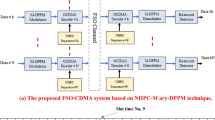Abstract
Free-Space Optical (FSO) can provide high-speed communications when the effect of turbulence is not serious. However, Space-Time-Block-Code (STBC) is a good candidate to mitigate this seriousness. This paper proposes a hybrid of an Optical Code Division Multiple Access (OCDMA) and STBC in FSO communication for last mile solutions, where access to remote areas is complicated. The main weakness effecting a FSO link is the atmospheric turbulence. The feasibility of employing STBC in OCDMA is to mitigate these effects. The current work evaluates the Bit-Error-Rate (BER) performance of OCDMA operating under the scintillation effect, where this effect can be described by the gamma-gamma model. The most obvious finding to emerge from the analysis is that the BER can be enhanced by orders of magnitude for different numbers of users and different values of scintillation effects using a MIMO channel as compared to Single-Input-Single-Output (SISO) one. The theoretical analysis of the derived BER, which is based on gamma-gamma model, is validated through the Monte Carlo simulation.
Similar content being viewed by others
References
P. Liu, P. T. Dat, K. Wakamori, M. Matsumoto, “A new scheme on time-diversity atmospheric OCDMA system over atmospheric turbulence channels,” Proc. of IEEE Globecom Workshop, 6–10 Dec. 2010, Miami, FL, USA (IEEE, 2010), pp. 1020–1025. DOI: 10.1109/GLOCOMW.2010.5700088.
N. Boudriga, W. Abdallah, M. Hamdi, “Physical layer cryptography in optical networks: A lattice–based approach,” Proc. of 12th Int. Conf. on Transparent Optical Networks, 27 Jun.–1 Jul. 2010, Munich, Germany (IEEE, 2010), pp. 1–7. DOI: 10.1109/ICTON.2010.5549040.
A. Litvinenko, A. Lboltins, “Selection and performance analysis of chaotic spreading sequences for DS–CDMA systems,” Proc. of Advances in Wireless and Optical Communications, RTUWO, 3–4 Nov. 2016, Riga, Latvia (IEEE, 2016), pp. 38–45. DOI: 10.1109/RTUWO.2016.7821852.
L. Yang, G. Shou, Z. Qian, Y. Hu, T. Miki, “OCDMA–WDM–PON with two–level chaotic logistic–map as spread spectrum sequence,” Proc. of Joint Conf. on OECC/ACOFT, 7–10 Jul. 2008, Sydney, Australia (IEEE, 2008). DOI: 10.1109/OECCACOFT.2008.4610530.
S. Donati, C. R. Rirasso, “Introduction to the feature section on optical chaos and applications to cryptography,” IEEE J. Quantum Electronics 38, No. 9, 1138 (2002). DOI: 10.1109/JQE.2002.801951.
M. P. Ninos, H. E. Nistazakis, G. S. Tombras, “On the BER performance of FSO links with multiple receivers and spatial jitter over gamma–gamma or exponential turbulence channels,” Optik 138, 269 (2017). DOI: 10.1016/j.ijleo.2017.03.009.
J. Ma, K. Li, L. Tan, S. Yu, Y. Cao, “Exact error rate analysis of free–space optical communications with spatial diversity over Gamma–Gamma atmospheric turbulence,” J. Modern Optics 63, No. 3, 252 (2016). DOI: 10.1080/09500340.2015.1075618.
E. Bayaki, R. Schober, R. K. Mallik, “Performance analysis of MIMO free–space optical systems in gamma–gamma fading,” IEEE Trans. Commun. 57, No. 11, 3415 (2009). DOI: 10.1109/TCOMM.2009.11. 080168.
A. Garcia–Zambrana, “Error rate performance for STBC in free–space optical communications through strong atmospheric turbulence,” IEEE Commun. Lett. 11, No. 5, 390 (2007). DOI: 10.1109/LCOMM.2007.061980.
K. Anbarasi, C. Hemanth, R. G. Sangeetha, “A review on channel models in free space optical communication systems,” Optics Laser Technol. 97, 161 (2017). DOI: 10.1016/j.optlastec.2017.06.018.
J. Park, E. Lee, G. Yoon, “Average bit–error rate of the Alamouti scheme in gamma–gamma fading channels,” IEEE Photonic Technol. Lett. 23, No. 4, 269 (2011). DOI: 10.1109/LPT.2010.2100815.
S. M. Alamouti, “A simple transmit diversity technique for wireless communications,” IEEE J. Selected Areas Commun. 16, No. 8, 1451 (1988). DOI: 10.1109/49.730453.
T. Huang, L. Wang, W. Xu, G. Chen, “A multi–carrier M–ary differential chaos shift keying system with low PAPR,” IEEE Access 5, 18793 (2017). DOI: 10.1109/ACCESS.2017.2752238.
A. J. Lawrance, G. Ohama, “Exact calculation of bit error rates in communication systems with chaotic modulation,” IEEE Trans. Circuits Systems I: Fundamental Theory Appl. 50, No. 11, 1391 (2003). DOI: 10.1109/TCSI.2003.818612.
G. Kaddoum, A. J. Lawrance, P. Charge, D. Roviras, “Chaos communication performance: Theory and computation,” Circuit Syst. Signal Processing 30, No. 1, 185 (2011). DOI: 10.1007/s00034–010–9217–1.
X. Yi, M. Yao, X. Wang, “MIMO FSO communication using subcarrier intensity modulation over double generalized gamma fading,” Optics Commun. 382, 64 (2017). DOI: 10.1016/j.optcom.2016.07.064.
X.–L. Liu, D. En, L.–G. Wang, “An optical CDMA system based on chaotic sequences,” Optoelectronics Lett. 10, No. 2, 126 (2014). DOI: 10.1007/s11801–014–3191–y.
X. Chen, D. Chen, Z. Wang, “Performance improvement of bandwidth–limited coherent OCDMA system,” Photon. Netw. Commun. 16, No. 2, 149 (2008). DOI: 10.1007/s11107–008–0126–1.
X. Liu, C. Yu, X. Xin, Q. Zhang, “Generator of optical chaotic sequences,” Electronics Lett. 43, No. 21, 1159 (2007). DOI: 10.1049/el:20071812.
E. Bayaki, R. Schober, R. K. Mallik, “Performance analysis of free–space optical systems in gamma–gamma fading,” Proc. of IEEE Global Telecommunication Conf., 30 Nov.–4 Dec. 2008, New Orlean, USA (IEEE, 2008), pp. 1–6. DOI: 10.1109/GLOCOM.2008.ECP.548.
J. Feng, X. Zhao, “Performance analysis of OOK–based FSO systems in Gamma–Gamma turbulence with imprecise channel models,” Optics Commun. 402, 340 (2017). DOI: 10.1016/j.optcom.2017.06.016.
A. J. Lawrance, J. Yao, “Likelihood–based demodulation in multi–user chaos shift keying communication,” Circuits Syst. Signal Process. 27, No. 6, 847 (2007). DOI: 10.1007/s00034–008–9063–6.
M. Shinozuka, A. Uchida, T. Ogawa, S. Yoshimori, F. Kannari, “Chaotic on–off keying method in microchip lasers for secure communications,” Proc. of Conf. on Lasers and Electro–Optics, 15–19 Jul. 2001, Chiba, Japan (IEEE, 2001), Vol. 2, pp. II–390–II–391, DOI: 10.1109/CLEOPR.2001.970998.
L. F. Abdulameer, U. Sripati, M. Kulkarni, “CSK based STBC–CDMA system: design and performance evaluation,” Association of Arab Universities Journal of Engineering Sciences 24, No. 1, 13 (2017). URI: https://www.jaaru.org/index.php/auisseng/article/view/21.
G. Kaddoum, D. Roviras, P. Charge, D. Fournier–Prunaret, “Robust synchronization for asynchronous multi–user chaos–based DS–CDMA,” Signal Process. 89, No. 5, 807 (2009). DOI: 10.1016/j.sigpro.2008.10.023.
M. Premaratne, F.-C. Zheng, “Orthogonal space-time block codes for free-space IM/DD optical links,” Electronics Lett. 43, No. 15, 822 (2007). DOI: 10.1049/el:20073712.
Author information
Authors and Affiliations
Corresponding author
Additional information
Original Russian Text © L.F. Abdulameer, 2018, published in Izvestiya Vysshikh Uchebnykh Zavedenii, Radioelektronika, 2018, Vol. 61, No. 10, pp. 577–591.
About this article
Cite this article
Abdulameer, L.F. Optical CDMA Coded STBC Based on Chaotic Technique in FSO Communication Systems. Radioelectron.Commun.Syst. 61, 454–466 (2018). https://doi.org/10.3103/S0735272718100035
Received:
Published:
Issue Date:
DOI: https://doi.org/10.3103/S0735272718100035




